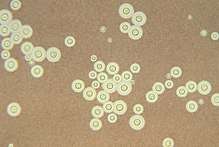Radiotrophic fungus
Radiotrophic fungi are fungi which appear to perform radiosynthesis, that is, to use the pigment melanin to convert gamma radiation[1] into chemical energy for growth.[2] This proposed mechanism may be similar to anabolic pathways for the synthesis of reduced organic carbon (e.g., carbohydrates) in phototrophic organisms, which convert photons from visible light with pigments such as chlorophyll whose energy is then used in photolysis of water to generate usable chemical energy (as ATP) in photophosphorylation or photosynthesis. However, whether melanin-containing fungi employ a similar multi-step pathway as photosynthesis, or some chemosynthesis pathways, is unknown.

Observations
Discovery
Radiotrophic fungi were discovered in 1991 growing inside and around the Chernobyl Nuclear Power Plant.[1] Research at the Albert Einstein College of Medicine showed that three melanin-containing fungi—Cladosporium sphaerospermum, Wangiella dermatitidis, and Cryptococcus neoformans—increased in biomass and accumulated acetate faster in an environment in which the radiation level was 500 times higher than in the normal environment. Exposure of C. neoformans cells to these radiation levels rapidly (within 20–40 minutes of exposure) altered the chemical properties of its melanin, and increased melanin-mediated rates of electron transfer (measured as reduction of ferricyanide by NADH) three- to four-fold compared with unexposed cells.[2] Similar effects on melanin electron-transport capability were observed by the authors after exposure to non-ionizing radiation, suggesting that melanotic fungi might also be able to use light or heat radiation for growth.
Comparisons with non-melanized fungi
Melanization may come at some metabolic cost to the fungal cells. In the absence of radiation, some non-melanized fungi (that had been mutated in the melanin pathway) grew faster than their melanized counterparts. Limited uptake of nutrients due to the melanin molecules in the fungal cell wall or toxic intermediates formed in melanin biosynthesis have been suggested to contribute to this phenomenon.[2] It is consistent with the observation that despite being capable of producing melanin, many fungi do not synthesize melanin constitutively (i.e., all the time), but often only in response to external stimuli or at different stages of their development.[3] The exact biochemical processes in the suggested melanin-based synthesis of organic compounds or other metabolites for fungal growth, including the chemical intermediates (such as native electron donor and acceptor molecules) in the fungal cell and the location and chemical products of this process, are unknown.
Protection against radiation
An experiment has been made at the International Space Station in December 2018 and January 2019 to test whether radiotrophic fungi could be used as protection against radiation, especially in space.[4] The experiment used Cladosporium sphaerospermum.[4] Results have been prepublished for peer-review in July 2020 and seem promising.[4]
References
- Science News, Dark Power: Pigment seems to put radiation to good use, Week of May 26, 2007; Vol. 171, No. 21 , p. 325 by Davide Castelvecchi
- Dadachova E, Bryan RA, Huang X, Moadel T, Schweitzer AD, Aisen P, Nosanchuk JD, Casadevall A (2007). Rutherford J (ed.). "Ionizing radiation changes the electronic properties of melanin and enhances the growth of melanized fungi". PLoS ONE. 2 (5): e457. Bibcode:2007PLoSO...2..457D. doi:10.1371/journal.pone.0000457. PMC 1866175. PMID 17520016.
- Calvo AM, Wilson RA, Bok JW, Keller NP (2002). "Relationship between secondary metabolism and fungal development". Microbiol Mol Biol Rev. 66 (3): 447–459. doi:10.1128/MMBR.66.3.447-459.2002. PMC 120793. PMID 12208999.
- Shunk, Graham K.; Gomez, Xavier R.; Averesch, Nils J. H. (2020-07-17). "A Self-Replicating Radiation-Shield for Human Deep-Space Exploration: Radiotrophic Fungi can Attenuate Ionizing Radiation aboard the International Space Station". bioRxiv: 2020.07.16.205534. doi:10.1101/2020.07.16.205534.